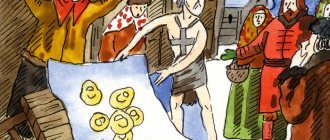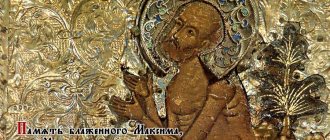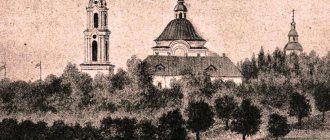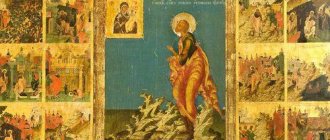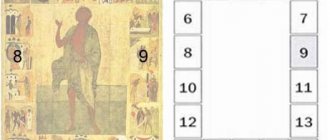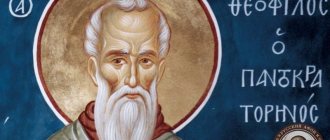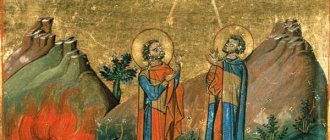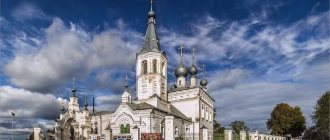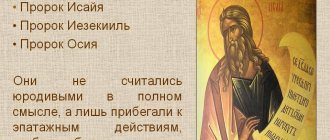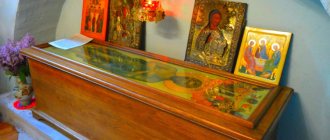Blessed John of Moscow, Big Cap, Fool for Christ's sake
Brief life of Blessed John of Moscow
He was born in the first half of the 16th century in the Vologda region and in his youth worked in salt mines.
He began acting as a fool when he moved to Rostov. He wore heavy chains and an iron cap on his head, for which he received his nickname. Around 1580, he visited Blessed Irinarch, the recluse of Rostov (1616; commemorated January 13/26) and predicted for him the invasion of the Poles and their defeat. He spent the last years of his life in Moscow, where even in the most severe frosts he walked almost naked, without taking off his iron chains. He fearlessly spoke the truth to everyone, often addressing the powerful of this world with an accusatory word, not sparing kings. Just before his death, the blessed one discovered the gift of healing.
Thus, one day, on the way from the temple, he healed a man who could not use his leg: the blessed one, as if accidentally stepped on his leg, and it became healthy.
He predicted his death, asking the rector of the Intercession Cathedral for a place for his burial. He died on July 3, 1589 and was buried in the Intercession Cathedral on Red Square. During his burial, a man who had suffered from an eye disease for twenty years was healed. The incorrupt relics of Blessed John were found in 1672.
The Complete Life of Blessed John of Moscow
Blessed John was born at the end of the 15th - in the first half of the 16th century. He is known for his deeds of piety in the era that preceded the time of troubles and danger for the Russian land. The blessed one was a native of the Vologda land. In his youth, he worked in salt factories, for which he was later called “The Water Bearer.” From here he went to Rostov, where he began a rare feat of foolishness. He began to wear an iron cap on his head, which is why he was nicknamed “The Big Cap.” He also wore tight iron rings on his fingers, and heavy chains of crosses on his body. The holy ascetic ate bread and water once a day. It often happened that Blessed John went out into the street, among the people, put his cap on the ground and, standing on it, looked at the sun for a long time and prayed. Passers-by laughed at him and insulted him, but the saint endured the ridicule with meekness and patience.
In Rostov he was acquainted with the Monk Irinarch, the recluse of Rostov († 1616; commemorated January 13/26). Having visited him once in Rostov (c. 1580), Saint John prophetically predicted the invasion of the Poles: “God will grant you to teach people from east to west, to fill the earth with disciples, to lead people away from drunkenness. For lawless drunkenness and debauchery, the Lord God will send foreigners to the Russian land... But the Holy Trinity will drive them out with His power.”
Blessed John spent the last years of his life in Moscow. He walked with his hair down, almost naked, even in severe frosts. His behavior was a challenge to worldly complacency, his actions and sometimes mysterious words hinting at a hidden daily life. Blessed John often addressed the mighty of this world with frank or accusatory words; even kings knew him, enduring from him what they would not have endured from another. So, to Tsar Boris Godunov he often said the words: “Clever head, sort out God’s affairs. God waits for a long time, but it hurts."
St. John himself predicted his death, asking Archpriest Demetrius, rector of the Church of the Intercession of the Most Holy Theotokos on the Moat, later called St. Basil's Cathedral, for his resting place.
The events preceding the death of the saint remained in people's memory. On the way from the temple, the blessed one healed a man who could not use his leg: as if by accident, the saint stepped on it, and his leg became healthy. Then he went to the bathhouse and there, having removed the chains for the first time, doused himself with water three times in preparation for burial. The saint commanded that the burial be performed no earlier than the third day. Then he lay down on a bench, asked everyone for forgiveness and bequeathed to take his body to the tomb of Blessed Vasily in the Intercession Church. With these words, Blessed John peacefully reposed before God on July 3, 1589 (1590).
Many contemporaries knew about his exploits. By decree of Tsar Theodore Ioannovich, the solemn burial of Blessed John was carried out. However, the burial itself took place not on the day indicated by the blessed one, but earlier. The Lord allowed a strong thunderstorm with lightning to happen as punishment for His saint’s failure to fulfill the covenant during the service, so that some icons in the Church of the Intercession were scorched and even several clergy and laity were injured. During the burial and later, many sick people received healing through the prayers of Blessed John. Blessed John also appeared to the sick who were far from Moscow, and they recovered.
Soon after the blessed death of St. John, the Moscow Wonderworker, a life and service were compiled. The relics of the saint were found incorrupt on June 12, 1672 and buried under cover in the chapel of the Nativity of the Blessed Virgin Mary in the Intercession Cathedral. And on January 17, 1916, this chapel was renamed in the name of Blessed John, Christ for the Holy Fool, Moscow Wonderworker. The saint is commemorated on the day of his blessed death - July 3/16 and on the day of the discovery of his incorruptible relics - June 12/25.
Blessed John, Tula Wonderworker
Memorial Days: January 12/25, July 21/August 3
Blessed John - Ivan Stepanovich Kotelnikov was born on September 23 according to the old style, and on October 6 according to the new style, 1773 in a wealthy merchant family from pious parents Stepan Romanovich and Anna Dmitrievna Kotelnikov. Baptized in honor of the holy Apostle John the Theologian. By nature, Ivan was talented and hardworking. Received a good home education. The father introduced his son to the trading business early. But his soul was not looking for earthly, perishable wealth. He read a lot, especially the word of God and the lives of the saints. His bright mind and kindest soul, enlightened by the grace of God, longed for other wealth. He very early understood the vanity and temporary nature of this life and with all his soul he rushed to God. With the blessing of Blessed Euphrosyne Kolyupanovskaya, the holy fool for Christ's sake, he embarked on the path of foolishness for Christ's sake. He was only 17 years old.
This feat, as it were, contains almost all other feats: monastic, ascetic, martyr and prophetic. Despite the apparent outward madness, there is hidden the hardest feat of fasting, prayer, patience with insults and ridicule and all the inconveniences of life - cold, hunger and everything else... Constant remembrance of the crucified Christ was for him like a song for a cherub. Having this unceasing memory of God, he always kept his right hand raised up.
According to the recollections of city residents, Blessed John walked in a striped robe, with an open chest, with his head uncovered, barefoot in winter and summer. His relatives, rooting for him in their souls, tried to dress him in good clothes, but it was all in vain. He immediately gave everything away, remaining in his rags. Love for his neighbors prompted him to visit those houses where there was trouble. He consoled in sorrows, encouraged in adversity, wept with those who wept, rejoiced with those who rejoiced, and helped the suffering with prayer.
People knew him as a man of God and learned from their own experience the truth of the words of Holy Scripture, which says that “the fervent prayer of a righteous man can accomplish much” (James 5:16).
Here is some information about Blessed John, collected by the priest Fr. Sergius Arkhangelsky and Ivan Matveevich Surikov, who each published their own book separately in 1912. They all talk about him as a great righteous man. Even during his life, he had from the Lord the gift of clairvoyance and miracle-working.
The people of Tula have preserved the memory of how the blessed one predicted the terrible fire of 1834. A few months before, he walked through the streets of the city, waving his arms and blowing in all directions. Just before the fire, the blessed one went around all the monastery cells and closed the chimneys everywhere. The monastery survived the fire, while all the buildings around were destroyed by fire.
On Vozdvizhenskaya Street there was a rich house of the landowner Esipov, and next to it was a poor hut of a widow with children. Ivan Stepanovich arrives and splashes water with a ladle all over the yard around the house and leaves. On the same day, a fire broke out in Esipov’s house, which destroyed an entire block of buildings, except for this poor hut. Many came to see this miracle.
Archpriest of the Peter and Paul Church V.N. Bogolyubov heard from his mother how the blessed one predicted her the death of her husband. And a few months later her husband, who had been healthy until then, suddenly fell ill and died.
A certain shepherd, guarding his flock, saw Ivan Stepanovich approach the Upa River and walk straight along the surface of the water. Seeing this, the shepherd was stunned. The blessed one approached him and said: “My soul, what you saw, don’t tell anyone until I die. If you tell, you will be severely punished.” The shepherd told about this incident when he came to say goodbye to the deceased.
Many, many such legends have been preserved about him. But it is not these deeds that most need to be remembered, but that inner feat, the great humility and humiliation of oneself, which led the blessed one to spiritual perfection. Often at midnight the holy fool was seen praying in front of the Life-giving Cross of the Lord, which was located on the porch of the Tula Assumption Cathedral in the Kremlin or on the porch in the St. Nicholas Church.
Throughout his adult life - 60 years, he carried out such a great feat: and externally - in the summer the bare feet of the holy fool were disfigured by the sharp stones of the pavement, and in the winter they had skin that burst from the cold. Even in severe frosts, he prayed and rested a little on the stone slabs of the church porch; and internal - a great feat of prayer, often hidden from people, but always pleasing to God. Some saw the blessed one praying in front of the Cross on the porch, surrounded by the bright radiance of God's grace and standing as if in the air. It was this grace and power of God that preserved and strengthened the Blessed One in his wonderful feat of foolishness.
He also predicted the day of his death, saying that “in 2 days they will have a feast!”, which exactly came true. The blessed elder died on January 12/25, 1850. Bishop Damascene, Tula and Belevsky, with a multitude of clergy and people, performed the funeral service for the deceased. The blessed one was buried on the porch of the St. Nicholas Church at the site of his exploits. Subsequently, the temple was enlarged in size with extensions, and the grave of the holy fool was inside the church.
In the 30s, when the temple was destroyed, the holy remains of Blessed John were transferred to the All Saints Cemetery. In 1988, on the 1000th anniversary of the baptism of Rus', the Bishops' Council of the Russian Orthodox Church canonized John Kotelnikov as a locally revered saint. In 1990, on August 3, Bishop Serapion, Metropolitan of Tula and Belevsky, with the clergy of the Cathedral, performed the discovery of his holy relics.
Troparion
You fought the feat of the foolishness of Christ for the sake of Christ, you appeared strange and wondrous on earth, with the flame of love for the Crucified Christ God, you incinerated the passions of the flesh, and from Him, even after death, you were united in the face of the inhabitants of heaven. With them, blessed Father John, pray for the salvation of our souls.
Source – Novomoskovsk Deanery of the Tula Diocese
COMMUNITY OF THE ORTHODOX CHURCH OF THE MOTHER OF GOD SOVEREIGN
John Bereslavsky is a bright and large-scale personality among the modern spiritual elite. Fearless, fiery, zealous, the common people call him Blessed John.
1 Born in 1946 in Moscow. Graduated from the Maurice Thorez Institute of Foreign Languages (1970). Worked as a translator and taught English. Around the same time he began his literary activity. For a long time he wrote “on the table”; he began publishing only in the late 80s. Studied at the Ippolitov-Ivanov Music College. Having received a classical education, he gradually converted to faith and joined the True Orthodox (Catacomb) Church, escaping communist influence.
bookmark |
Anointed Wisdom
2 In 1985, John Bereslavsky was ordained a priest of the True Orthodox (Catacomb) Church, since 1992. - bishop. Having been consecrated by Metropolitan John Bondarchuk of the UAOC, Blessed John became the heir to the mystical traditions of the True Orthodox Church, leading the succession from Patriarch Tikhon and the Council of Solovetsky New Martyrs led by Patriarch-Martyr Seraphim of Solovetsky, who spent 39 years in Stalin’s Gulag camps.
3 Currently, he is the spiritual head of the Russian Orthodox Church of the Mother of God Sovereign (heads the Council of Bishops), and is in communication with prominent representatives of the intelligentsia and religious figures of Christianity, Islam and Buddhism in many countries.
4 His spiritual growth was greatly influenced by his acquaintance with the holy prayer book - Elder Euphrosyne from Pochaev, who revealed to him the beauty of practical asceticism, the senile Orthodoxy of the Holy Spirit.
bookmark |
Spiritual quest
5 In November 1984, the first books of Blessed John about the revival of holiness and spirituality in Russia began to be published.
6 The spiritual path of John Bereslavsky is inseparable from his creative talents. Wrote poetry. He belonged to the circle of Moscow poets of the 60s, and was in close contact with Andrei Voznesensky and Bella Akhmadulina. Studied Hebrew and Greek. In his youth, even before his conversion, he was the author of several novels and stories, collections of poems, and numerous theological, journalistic and religious-philosophical works. However, early religious aspirations forced him to quickly break with literary bohemia. A passion for philosophy, Hebrew, Greek, ancient and medieval mysticism followed.
7 His diverse creativity reflects the entire disharmonious palette of the modern world with its foolish corruption and heavenly heights. Perhaps that is why his spirituality (possessing a certain “aristocratic madness”, heavenly height and at the same time knightly generosity - Pushkin’s “mercy for the fallen”), his “sense of God” touches both intellectuals and youth “not spoiled” by book culture.
bookmark |
Creativity and works
8 In the early 90s, through the efforts of like-minded people, a charitable foundation and publishing house was organized, which became known as the Center of the Mother of God in Russia, legally - the Public Educational Foundation “Theotokos Center”, named in honor of the Blessed Virgin Mary, the patroness and intercessor of the Russian land.
9 A genius of prophetic thought and a master of words, Father John wrote many books and articles, several multi-volume publications, many of which were translated into other languages. Among them are 40 volumes of the Word of the Mother of God - unique texts of living revelations of the Mother of God and the Lord in Russia and around the world with commentaries and editing by Blessed John of Bereslavsky. Through the joint efforts of Father John’s collaborators and like-minded people, the chronicle of the Russian Revelation, a 7-volume volume about the secrets of the Second Solovetsky Golgotha, was prepared for publication. The works of Blessed John convey the idea of the messianistic destiny of man, as the image and likeness of God, revealed in indescribable kindness, purity, beauty and non-covetous life, which was taught by Francis of Assisi, St. Nil Sorsky, St. Seraphim of Sarov, Leo Tolstoy and others.
10 After the fall of communism, an important factor in the bloodless development of events in Russia was the establishment by Father John of the revival movement “New Holy Rus'”, which included representatives of the thinking intelligentsia, priests, philosophers and many others. others - everyone who rooted for Russia with their hearts and souls.
11 As a participant in the events of August 91, he met with many political leaders in order to prevent bloodshed and violence, convincing them of the need to resolve the conflict peacefully.
12 The active anti-communist position of Father John became another reason for the rejection of the imaginary ideals of the atheistic era, the call to get out of the crisis and spiritual stagnation, and turn to true spiritual values. He was the first in Russia who, after the fall of the communist regime, brought back to life the national idea - the messianism of the Russian people through the establishment of the ideals of the New Holy Rus'. His “divine call to the suffering Russian people to return to the eternal axioms of meaningful and active pursuit of truth, morality, love and beauty, about divine providence, in accordance with which the Russian nation must determine its future path.”
13 He was one of the few who seriously analyzed and described the deep crisis of the modern church in the twentieth century. It is here, in his opinion, that lies the main reason for the spiritual degradation of modern society. The breadth of his worldview and the scope of his mind allow Blessed John not to limit himself to the framework of a particular confession, people or tradition, but to reveal the spiritual path in many ways as a unity of spiritual, moral ideal for humanity, which has universal importance and significance.
bookmark |
Post-communist period
14 The conflict between old and new worldviews is eternal, incl. its religious and ethical components. Given the novelty and originality of Blessed John, it is not surprising that there are opponents accusing him of “failure to follow fundamental church instructions and canons.” Thus, individual representatives of religious traditionalism, fundamentalist-minded, because of personal interests, boycott Father John and his works, not wanting to admit their own spiritual inconsistency.
15 The conflict of two worldviews at all times results in the struggle of novelty to preserve their originality and living individuality against the framework of established and outdated traditions, dead schemes. Related to this are numerous attacks by adherents of traditional church institutions on the activities of Blessed John - as an instrument of the Divine will, revealing to humanity the spiritual world as the highest reality of existence.
16 Father John calls on modern man to restore the conscience damaged by sin and compromise. As a practice of faith, it is characterized by deep churchliness and loyalty to high moral ideals. He courageously and uncompromisingly defends his own point of view, forming a completely new view on various spheres of the secular and spiritual life of society. In the works of Blessed John there is no deliberate secularism, a surface that is characteristic of many religious researchers and publicists who observe religious processes “from the outside.” His view is always internally justified and convincing, conclusions and conclusions are based on deep knowledge of the subject and the timeliness of the spiritual concept he presents.
bookmark |
Writer, thinker, prophet
17 Blessed John Bereslavsky is an outstanding researcher of world philosophical thought, an expert on the apparitions and revelations of the Mother of God around the world. He is the author of extensive studies of outstanding people of Russia and the world. Today, the multi-volume composition of his works represents a huge library, the study of which could take a lifetime.
18 His books are translated into different languages. They are read with equal enthusiasm by people of different ages, occupations and interests. He attaches great importance to the authenticity of the translation of sacred and spiritual texts into the languages of the world, and in his own research he uses a comparative analysis of the ancient languages of the Judaic cycle (such as the Torah, Talmud, Mishnah, Perke Abot), the Bible, apocryphal writings of the Old and New Testaments, ancient documents and manuscripts, writings of the holy fathers of Christianity, Western and Eastern mystics and hesychasts. The wisdom of the teachers of Sufism and Zen Buddhism is available to him. The crown of his spiritual research is the works of recent years devoted to Theogamy (Divine Matrimony), which reveals the purpose of coming into this world and the highest purpose of man as the image and likeness of God - entering into a spiritual marriage with God, uniting into one with the Divine.
19 People's Artist of the Russian Federation, full member of the Russian Academy of Arts Andrei Andreevich Tutunov writes: “A huge library of books about. John is a spiritual treasure trove for modern society. In his books, he presents a synthesis of many years of mystical revelations of the Word of Our Lady throughout the world, reflecting the multifaceted experience accumulated over the centuries...”
20 English biographers are interested in his work. As an outstanding thinker of our time, Blessed John Bereslavsky is among the elite of intellectuals of the world - this is how the English catalog “Who is Who” describes his activities, noting the special contribution of Blessed John to the treasury of the world community.
bookmark |
New shapes and styles
21 Blessed John created a new theological school of the Melchizedek priesthood, raising hundreds of the most talented and gifted students of Wisdom. His students become bright thinkers, theologians and mystics, continuing to develop the spiritual tradition of the Slavic-Theogamic theological school.
22 In the sphere of worship, Blessed John developed the concept of completely new approaches to the liturgy, revealing the essence of worship in a variety of forms, making it accessible to ordinary people, and at the same time revealing at a new height the whole depth and beauty of the liturgy, embodied incl. in new robes, banners and iconography. Mystery is of utmost importance in worship; it includes plastic prayer as an expression of the language of the heart in the form of plastic movements.
23 In the vocal-instrumental sphere, he introduced a whole series of new expressive elements using the richness of melodies and phonetics of ancient and modern European languages, and also compiled a new unique system of church modes and voices. In the creative art workshop, his students create masterpieces of painting and craftsmanship, and develop new artistic forms and styles.
24 He introduced a new concept of education for children and teachers by founding the institution of the family. The basis of this concept is a special understanding of education as an inspired knowledge of the depths of universal human truths through righteousness, holiness, spirituality outside of formalism and scolding, through instilling a love of learning, of the teacher and the ability to achieve deep dialogue.
bookmark |
Spiritual leader and peacemaker
25 As a spiritual leader, Blessed John has senile and prophetic charisma, and as a church shepherd, he inherits the patristic tradition of non-covetous, ascetic, spirit-bearing Orthodoxy and light-centric Christianity, paying special attention to the path of holiness through the practice of the holy ascetic fathers.
26 It is noteworthy that he communicates not only with other branches of Christianity, but also with other religions, such as Islam, Buddhism, etc. His circle of friends includes sheikhs, cardinals, spiritual leaders, and politicians. Along with his openness and dialogical nature, his ability to present Divine messages and prophetic texts in an accessible and clear manner, revealing deep secrets and mystical heights, is striking. As a spiritual leader, he traveled half the world and held many conferences and meetings. At one of the meetings, the leader of Russian Muslims, Heydar Dzhemal, said that the experience of Father John is invaluable for the Muslim world.
27 For his creative and social activities, Blessed John was awarded a number of international awards and honorary titles. His contribution to the cause of strengthening peace has been repeatedly recognized by the International Association of Teachers for World Peace under UNICEF and UNESCO. His desire to unite the progressive Russian creative and spiritual intelligentsia resulted in the creation in 1995. in St. Petersburg "Independent Association of Russian Religious Writers and Philosophers."
bookmark |
Originality and versatility
28 There is probably no genre in which Blessed John would not work. Divine sermons, exegesis, historical essay, current journalism, philosophical diaries, satire, spiritual tales and parables, original mystical poetry comparable to Russian and world spiritual classics (remember Juan de la Cruz, “The Book of the Dove,” Rumi, Tagore), research and translation of the books of the Bible, dogmatic theology, aphorism, mystery... And everywhere, even in the most serious and difficult works for the uninitiated reader, there is the freedom and liveliness of presentation characteristic of the author, clarity and some kind of unearthly illumination, conveyed beyond words.
29 The topics addressed by the author are also very diverse. First of all, this is the image of God, as He can be seen by modern man, who has known the highest ascents of the spirit and falls into the abyss of the deepest insignificance, a man who is mad, if not from devilish temptations, then from divine ecstasy. Through the prism of this vision of God (nothing like this can be found today in any of the theologians of the “traditional” school), Blessed John comprehends the history of the Universal Church, the interconnection of world religions, the secrets of the human soul and the spiritual path. This understanding is always new, bright and deeply grounded.
bookmark |
His books are living writings
30 The books of Father John, as the author himself says, reflect the facets of a certain eternal “Universum of Wisdom”, which unites all the fabrics and layers of existence. The highest level of spirituality, the height of creative insight and the depth of prophetic vision, bring undoubted fruits of the work of Blessed John. According to one of the historians of Russian culture, “the stamps of practical spirituality found in his works, the deep continuity of images and relationships reveal in him the recipient of the mystical experience of the greatest Russian saints, directly transmitted to him from the living bearers of the grace and blessing of the Solovetsky new martyrs.”
31 A separate theme in the work of Blessed John is Solovki. In the 18th century, on the island of Anzer, the Most Holy Theotokos appeared to the monk Jesus and said that the Second Golgotha of Her Divine Son would be erected on this place, and rivers of blood would flow here. This prophecy was fulfilled during the years of Stalin's terror. The six-volume cycle of spiritual and historical essays “Solovki - the Second Golgotha” describes the phenomenon of the Russian Golgotha of the twentieth century. The Solovetsky Golgotha is not an allegory, not a symbol or a metaphor, the author claims, but a historical and spiritual reality that is of extreme importance for the future of Russia and the world.
32 Among the books of Father John, a special category consists of the heavenly revelations he received from God and the Blessed Virgin Mary, angels and saints through spiritual “inner hearing.” This unprecedented gift is rare these days. Collections of revelations meet with an interested response from mystics, theologians and religious intelligentsia in Russia and foreign countries. Many people perceive them with hostility, but the content and the very phenomenon of these revelations are certainly important for the modern reader interested in problems of spirituality.
bookmark |
Finally
33 For many today it is obvious: Father John is an outstanding representative of the Russian religious intelligentsia, who embodied in his life, asceticism and creativity its best qualities: high culture, broad erudition, freedom and courage of views, sincere pain for the fate of the fatherland and civilization, wisdom and simplicity, prophetic power that allows us to see the coming age. In recent years, Blessed John has traveled extensively throughout European countries, North America and East Asian countries on a peacekeeping mission, where he never tires of teaching about the spiritual and universal truths revealed to him by Divine Wisdom.
34 The books of Blessed John are now available to foreign readers who are interested in the activities of Blessed John, which led to the emergence in Russia of a Russian theological school unsurpassed in its scale.
70
Some numbers and facts
Ivan Stepanovich Kotelnikov died in 1849, and during his life he did many good deeds. A lot of people came to say goodbye to him. The body of the blessed elder was buried in the same St. Nicholas Church, in the corner of the left side, in accordance with the will of the deceased.
Subsequently, the temple was enlarged in size with extensions, and the grave of the holy fool was inside the church. In the 30s, when the temple was destroyed, the holy remains of Blessed John were transferred to the All Saints Cemetery. In 1988, on the 1000th anniversary of the baptism of Rus', the Bishops' Council of the Russian Orthodox Church canonized John Kotelnikov as a locally revered saint. In 1990, on August 3, Bishop Serapion, Metropolitan of Tula and Belevsky, with the clergy of the Cathedral, performed the discovery of his holy relics.
That's probably all. Yes, of course, it worked out a little, but still, the most important thing, without unnecessary words and lofty speeches. It seems to me that such things are important to know in their own way. This is not even a matter of faith, but at least from a cultural point of view. And whatever one may say, this is part of our history.
That's all for now, see you soon.
